A Government-Subsidized Desert Death Ray
By Norman Rogers
AmericanThinker.com
The Ivanpah solar generating plant is located in California about 50 miles from Las Vegas near the California-Nevada border. 173,000 mirrors are used to concentrate the sun on 3 boiler-towers where water is turned into steam to drive turbines and generate electricity. The mirrors track the sun and concentrate sunlight so that the intensity of light falling on the boiler-towers is about 500 times stronger than sunlight -- a death ray. If a person were to be illuminated by this death ray, 3rd degree burns would follow within a few seconds. Insects that wander into the kill zone are quickly vaporized. Birds are severely burned or killed depending on how long they are in the kill zone. An aerial view is below. Only one tower was operating when the photo was taken.
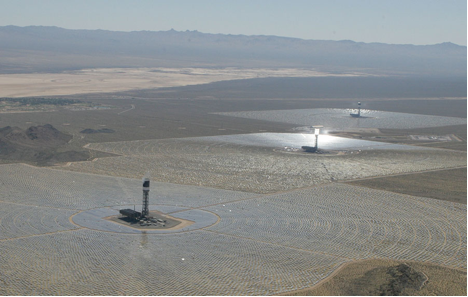
The next photo is taken from a vantage point near the boundary fence and shows mirrors and one of the towers. The massive tower is about 3/4th of a mile away.
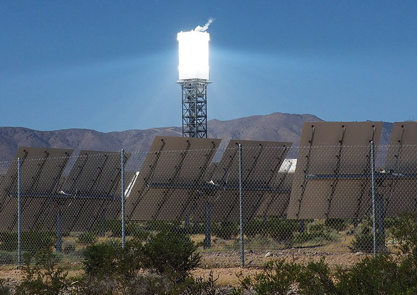
In order to get close up photos and videos of the kill zone I used the rig in the picture below.
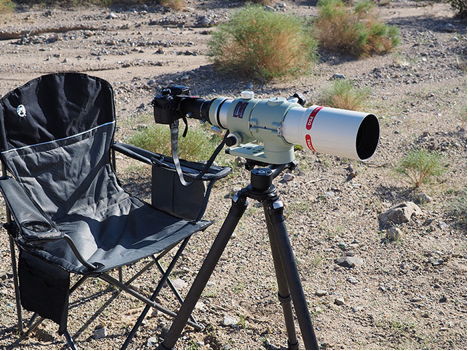
The photo below shows insects that have entered the kill zone being vaporized. The very bright and hot tower is on the right. The debris is swept upwards by the rising hot air. Even though the photo is taken through a telescope more than a half-mile away, the intense illumination makes the insect debris visible.

Below is a video showing a bird getting smoked in the kill zone. The bird enters at lower center. The flapping of the wings is visible. The bird flies up and about halfway up starts smoking. The bird then gets out of the kill zone and flies in the direction of the hot collector. Just before the bird disappears behind the collector it is smoked again. While the bird is flying a number of insects are vaporized in the frame, with their debris swept upward by rising hot air.
Bird Smoked at Ivanpah -- Probably dies. from Norman Rogers on Vimeo.
Below is a photo of a bird reported to the California Energy Commission. This particular bird was found about a mile away from the tower.

Apparently the bird had much of its wings burned or melted, but it was still able to fly a considerable distance. It was still alive when found on a roadway. Probably several thousand birds will be killed each year. Dead birds that are found are reported to the energy commission. Apparently the larger raptors stay away from the tower and most of the dead birds are smaller birds. The death of a few thousand birds each year is not a threat to the millions of birds, but the psychological damage to solar energy is considerable. For this reason the Ivanpah operators and government agencies downplay the bird problem and are probably searching for methods to scare birds away from the towers. Birds being covered with feathers may be fairly resistant to the intense light. However one wonders if their eyes are more sensitive and if they may be blinded before their feathers start to smoke.
The Sacred Tortoises
The desert tortoise is an interesting animal. They live on approximately 6 million acres of the Mojave desert. Their life expectancy is similar to that of humans. They eat plants and can survive very well with little or no water beyond what they get from the plants. During mating season the males fight each other, each trying to tip over their opponent. Most of the time the upside down tortoise can eventually right itself, but in the meantime the victor tortoise presumably has his way with a nearby female.
In the 1980’s a virus killed an alarming number of tortoises causing them to be classified as a threatened species. The virus threat petered out and there are now probably 100,000 or more tortoises living over a wide swath of the desert. However, once classified as threatened, the tortoises become a bureaucratic and academic gold mine. So, the threatened classification has never been lifted in spite of the existence of a large and widely dispersed population.
About 75 biologists are employed at Ivanpah. Biologists study and protect the 100 or so adult desert tortoises encountered on the Ivanpah site. Tortoise-proof fences have been erected. Adult tortoises have had radio tracking devices cemented to their shells. Baby tortoises have been placed in a nursery where they can grow for 5 years until they can be turned loose in the desert. Below is a photo of a tortoise with a radio tracking device that I encountered while prowling in the desert around the Ivanpah site. The tortoise is eating some grass.

The tortoise that I found showed little fear. A video is here. An acquaintance of mine who has lived his entire life in the Las Vegas area told me that when he was a kid he had a pet desert tortoise.
In the photo below biologists are walking the desert searching for tortoises at the site of a new, proposed photovoltaic solar electricity plant adjacent to the Ivanpah site. The tortoises will be relocated on the other side of a tortoise proof fence surrounding the site.
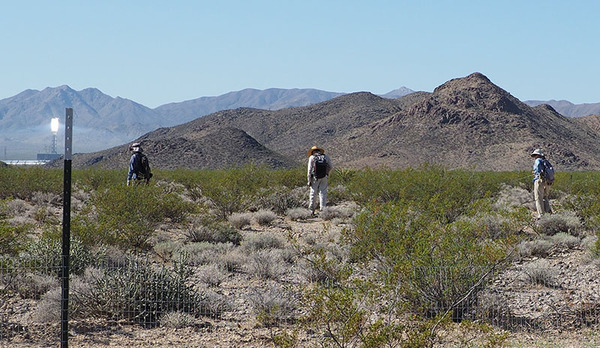
Here is a photo of a tortoise fence and what appears to be something like a cattle guard for tortoises. If the tortoise tries to cross it will fall into a ditch below and can walk out at either end of the guard.
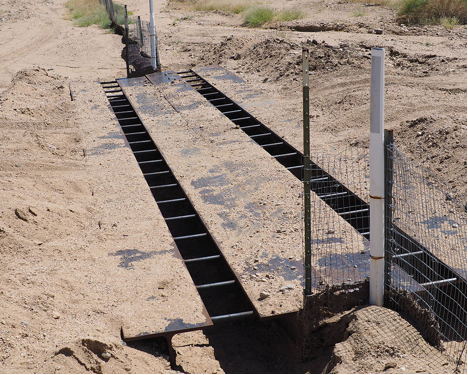
Obviously the huge bureaucratic effort launched on behalf of a handful of tortoises is misplaced. However the blame should not necessarily be completely placed on the government or the Bureau of Land Management. Government employees are hemmed in by legal constrictions and by the ever-vigilant environmental organizations that are always ready to sue unless they are bought off. The problem is the legal framework established by the endangered species act and court decisions. Of course the beneficiary environmental organizations will fight against any rational reform that might make them financially endangered.
Solar Energy Finance
The Ivanpah solar plant could not remotely stand alone as a viable project without massive subsides from the federal and state governments. As a starter, the Department of Energy provided a government guaranteed loan for $1.6 billion. My guess is that the interest rate on such a loan is around 3.5% for a 25-year loan. The federal government additionally provides a 30% investment tax credit worth about $600 million. Solar power has no cost for fuel, so capital costs are critical. A low interest rate makes all the difference. Based on a 3.5% cost of money, A $2.2 billion project cost, a 30% Investment tax credit discount, and 1000 gigawatt hours of annual generation, the capital cost of Ivanpah electricity would be around 8.5 cents per kilowatt hour.
If the Ivanpah project were done on an unsubsidized basis, with equity capital at a more reasonable12%, the capital cost of the electricity would be about 26 cents per kilowatt hour. There are many more subsidies. Solar energy plants designed to last for 25 years can be depreciated for tax purposes over 5 years, a valuable tax benefit. There is an array of California subsidies in addition to the federal subsidies. The greatest California subsidy is the so called renewable portfolio standard that gives a preference to “renewable” solar energy and sets quotas for the power companies. This forces the power companies to contract for solar energy at a high price rather than buying much cheaper energy from natural gas or coal. Exactly how much the power companies are paying for Ivanpah energy is kept secret, but sources suggest that it is probably about 9 cents per kilowatt hour, with inflation adjustments and guaranteed purchase of all output for 25 years. Energy from natural gas can be supplied more flexibly, including at night, for about half as much. The extra cost of solar is buried in consumers’ electric bills. The same consumers are also paying the taxes that support the many other subsidies. In one-way or another the citizens are paying something like 25 cents for 5-cent electricity.
The above estimates should not be taken as exact calculations. The total value of all subsidies is undoubtedly much greater than the value of the subsidies listed above. High priced lawyers charge dearly to structure these complicated deals. Google invested $168 million in the project. However Google expects a return of 10% or more per year on its investment. Some of the tax benefits are surely being transferred to Google. Being a highly profitable company with a large tax bill, Google can essentially buy the various tax breaks associated with solar electricity. Google’s California tax bill is no doubt huge and it is probably no accident that the plant is located just across the California-Nevada state line in California, so as to be able to fully qualify for California subsidies. Google gets a profitable place to invest some of its excess cash and Google gets to polish its green image. Google’s green image might suffer if the citizens understood that Google is cooperating with other self-serving entities in stuffing over-priced green electricity down their throats.
Ivanpah Electricity is non-Dispatchable
The controllers of electric grids want to be able to dispatch electricity from various plants. Generally the plants generating the cheapest electricity are used first and as demand increases, often in the late afternoon, more expensive plants are bought on line. For example the cheapest plants, often nuclear, coal, or combined cycle natural gas, are considered base load plants and may run 90% of the time. More expensive sources of electricity, such as peaking gas turbines, are used only when the load becomes very high, perhaps for a few hours a day. However, the grid is forced to take everything that Ivanpah can generate even though the cost is probably higher than nearly everything else. In order to meet the renewable portfolio standard quotas, the power companies need to get all the solar energy they can, regardless of cost. The power companies don’t care about the cost as long as the regulators allow it to be passed on to the consumers. The highly political, and global warming-believing, California Public Utilities Commission is only too happy to oblige.
Photovoltaic versus Thermal Solar Electricity
Solar electricity only makes sense if you believe in the now implausible threat of global warming and if, in addition, you have an irrational hatred of non-CO2-producing nuclear energy. That is pretty much the viewpoint of environmental groups and the left side of the Democratic Party.
Photovoltaic solar electricity is produced by silicon-based panels that generate electricity directly, usually converting 10% to 15% of the energy falling on the panels into electricity. Thermal solar electricity generally uses mirrors to concentrate sunlight and boil water, or other fluid, to drive a turbine-generator. About 30% of the energy falling on the boiler may be turned into electricity. Since the mirrors need to be spread out to prevent shading and to allow for maintenance, much of the sunlight falls on the ground and is not converted to electricity.
The applications of solar energy that are actually useful are small niche applications, such as electricity for people who live out of the reach of the electric grid or for emergency telephones along highways where little power is needed and running power cables would be expensive. These applications use rechargeable batteries to extend the solar electricity into cloudy days and the night. Batteries are hopelessly overpriced for large-scale grid applications.
A genuinely practical use of solar energy is the heating of swimming pools. No electricity is involved, only solar collectors to raise the temperature of the water pumped through the collectors by a few degrees.
But, it is interesting to compare the virtues of photovoltaic and thermal solar electricity, particularly since billions of dollars are being spent by the government on such projects.
Photovoltaic systems are cheaper to build but thermal systems have potential advantages. Neither system works at night or when it is cloudy. Solar will be of limited use unless electricity can be provided at night and on cloudy days. There is only one practical large-scale method of storing electricity -- pumped storage. But pumped storage requires large reservoirs located at different heights with a hydroelectric plant that can generate electricity or store energy by using electricity to pump water from the lower reservoir to the upper reservoir. Pumped storage involves capital cost, power lines, and is only possible in regions with mountainous landscapes that are suitable for large reservoirs. Pumped storage is mostly a niche solution.
But, there are tricks that can be used with thermal plants, but not with photovoltaic plants, to provide electricity when sunlight is absent. Natural gas or other fuel can be used to produce steam when sunlight isn’t available. Much of the equipment is shared. The Ivanpah plant is connected to a natural gas line and can generate electricity using it. This generally is not as efficient as the most efficient natural gas-only plants, but at least it provides a bridge when sunlight is not available. A second trick is to store heat in a tank of melted chemical salts for use at night. Enough heat can be stored in a manageable sized tank to produce electricity for many hours.
Can Grid Scale Solar Electricity Ever be Practical?
My guess is that solar electricity it will never be practical on grid scale, but that is only a guess. The question is always, what’s the alternative? Photovoltaic panels have reached efficiencies over 40% in laboratories. If such panels could be manufactured as cheaply as current 15% efficient panels, that would widen the possibilities for photovoltaic solar plants.
There are places in the world where oil is used to generate electricity, for example Hawaii or Newfoundland. Generating electricity from $100 per barrel oil costs about 25 cents per kilowatt-hour, mostly for fuel, because oil is a very expensive, premium fuel. One could ask if solar is a practical alternative for these places. It is likely that the plants burning oil were built when oil was cheap. Coal is a much better alternative. Coal is an extremely cheap fuel that can be transported by ship. Coal is 5 or 10 times cheaper per unit of energy compared to oil. So, if places where oil is used want to develop new and more economical sources of electricity, coal is the obvious solution, not solar (or wind). Believers in global warming, who dislike coal, would have to take into account an emerging technology of small nuclear plants that is on the drawing boards and that potentially could generate CO2-free electricity very cheaply.
Newfoundland is cloudy and has poor sunshine because it is too far north. But Newfoundland has an alternative. There is a vast hydroelectric resource across the 11-mile wide Strait of Belle Isle in Labrador. Undersea power transmission is possible. Hawaii, in contrast, actually has sunshine and locations without too many clouds. But on the most populated island, Oahu, land is expensive and in short supply.
Could the cost of unsubsidized solar electricity ever be bought down to a competitive level of 5 cents per kilowatt-hour instead of the current 25 cents? The first necessity would be cheaper money. Due to the risk and experimental nature of solar electricity a realistic unsubsidized interest rate is around 12%, in my opinion. But if solar were competitive and reliable, the free market might supply money at 5%, reducing the 25 cent cost per KWH to about 10 cents. Then if larger plants with heat storage could be built at half the capital cost per KWH the economics would become more realistic. Heat storage is necessary because what good is a plant that doesn’t work at night? If the plant doesn’t work at night, another plant has to be built to cover the night. Solar plants would have to be built in the southwest where sunshine is plentiful. Moving the power thousands of miles is expensive, so the service area might never expand beyond the southwest. The Ivanpah plant occupies 6 square miles of public land and is located near an existing power line and a natural gas line. If these facilitates had to be paid for at market rates the cost would be increased. A utility scale plant that could provide 500 megawatts into the evening would probably be double the size of Ivanpah. Ivanpah has an efficiency of about 30% converting sun energy falling on the tower to electricity. By running at higher temperatures and using a cooling tower rather than air cooling the efficiency might be improved to 40% or even higher. In theory, extremely high temperatures are possible. A cooling tower requires water, in short supply in the sunny desert. A lot of land is wasted because the mirrors have to be spaced apart so that they don’t shade each other when the sun is low in the sky. Perhaps a better mirror scheme will be developed.
If there were not many alternatives, perhaps thermal solar power could be made fairly competitive. But why bother then there are so many alternatives? The U.S. is sitting on huge reserves of coal and natural gas. Factory built, CO2-free, nuclear plants that are meltdown proof, breed fuel, burn up waste, and that are buried under ground are in development. Nuclear fuel is cheap and virtually unlimited. Why put billions into marginal solar energy when nuclear technology is despised and starved? Reducing CO2 emissions is a fool’s errand because anything we do will be cancelled out many times over in China and India. In any case, the science behind global warming is falling apart because the Earth is failing to warm and because the skeptics are punching bigger and bigger holes in the “science.”
Norman Rogers is a retired entrepreneur who writes about global warming and renewable energy. He is a volunteer Senior Policy Advisor with the Heartland Institute, a Chicago think tank. He maintains a website.

